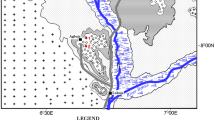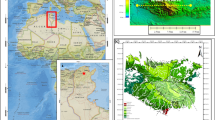Abstract
This new study was carried out in order to accurately characterize the geochemical pattern of Ousselat organic-rich facies from the Ypresian basin in central-northern Tunisia. It has been found that the organic matter is located towards the end of diagenesis/beginning of catagenesis. This assumption is supported by the relative low T max values (429–439°C) and by steranes maturity parameters such as C29 αα 20S/(20S + 20R), and C29 ββ/(ββ + αα). High HI values and the abundance of saturates (1–83%) compared to aromatics (2–27%) are unequivocal evidence of type-II organic matter as indicated by a high abundance of cholestane and the predominance of short-chain n-alkanes centred at n-C18 and at n-C20. Total organic carbon (TOC) content and petroleum potential values suggest that the Ypresian period corresponds to an anoxic event which led to the accumulation and preservation of large quantities of organic matter with high primary production. Due to their geochemical characteristics, the Lower Eocene facies represent a new potential source rocks in central-northern Tunisia.
Similar content being viewed by others
References
W. P. Bishop, Petroleum Geology of East-Central Tunisia, Am. Ass. Petrol. Geol. 72, 1033–1058 (1988).
A. Zaïr, A. Beji-Sassi, S. Sassi, and R. T. J. Moody, “Basin Evolution and Deposition during the Early Paleogene in Tunisia,” Geol. Soc. London, Spec. Publ., 132, 375–393 (1998).
Contribution à Létude Stratigraphique de la Tunisie. Centrale, Ed. by P. F. Burollet, Ann. Mines Geol. Tunis, 18, 1956.
N. Boukadi, S. El Ayeb, and S. Kharbachi, Analyse Quantitative de la Fracturation des Calcaires Ypresiens en Tunisie: Pexemple de Jebel Ousselat, Bull. Soc. Geol. France, 171, 309–315 (2000).
E. Vennin, F. S. P. van Buchem, P. Joseph, F. Gaumet, et al., “’A 3D Outcrop Analogue Model for Ypresian Nummulitic Carbonate Reservoirs: Jebel Ousselat, Northern Tunisia,” Petroleum Geosc. 9, 145–161 (2003)
A. Rigane, C. Gourmelen, P. Broquet, and R. Truillet, “Originalité des Phénomènes Tectoniques Syn-Sédimentaires Fini-yprésiens en Tunisieycentro-Septentrionale (région de Kairouan),” Bull. Soc. Géol. France, 165, 27–35 (1994)
J. Espitalié, J. L. Laporte, M. Madec, et al., “Méthode Rapide de Caractérisation des Roches Mères, de Leur Potentiel Pétroliert de Leur Degré d’Évolution,” Rev. Inst. Français Pétrole, 32, 23–42 (1977).
B. P. Tissot and D. H. Welte, Petroleum Formation and Occurrence, (Springer Verlag, New York, 1984).
B. Duran, “Composition and Structure of Organic Matter in Immature Sediments,” in Applied Petroleum Geochemistry, Ed. by M. L. Bordenave (Editions Technip, Paris, 1993), pp. 77–100.
D. W. Waples, Geochemistry in Petroleum Exploration, (Reidel Publishing Company, Boston, 1985).
T. Yamanaka, C. Mizota, T. Murae, and J. Hashimoto, “A Currently Forming Petroleum Associated with Hydrothermal Mineralization in a Submarine Calderas, Kagoshima Bay, Japan,” Geochem. J. 33, 355–367 (1999).
A. Nissenbaum, M. Glodberg, and Z. Aizenshtat, “Immature Condensate from Southwestern Mediterranean Coastal Plains, Israel,” Bull. Am. Ass. Petrol. Geol. 69, 946–949 (1985).
M. L. Bordenave, J. Espitalié, P. Leplat, et al., “Screening Technique for Source Rock Evaluation,” in Applied Petroleum Geochemistry, Ed. by M. L. Bordenave (Editions Technip, Paris, 1993b), pp. 246–250.
A. S. Pepper and P. Corvi, “Simple, Kinetic Models of Petroleum Formation. Part I: Oil and Gas Generation from Kerogen,” Mar. Petroleum Geol. 12, 291–319 (1995).
The Biomarker Guide. Interpreting Molecular Fossils in Petroleum and Ancient Sediments, Ed. by K. E. Peters and J. M. Moldowan, (Prentice-Hall, Englewood Cliffs, 1993).
J. Espitalié, G. Deroo, and F. Marquis, “La Pyrolyse Rock-Eval et Ses Applications,” Rev. Inst. Franc. Pétrole, Part I, 40, 563–578, Parti II 755–784 (1985).
Y. Huang, F. A. Street-Perrott, F. A. Perrott, et al., “Glacial-Interglacial Environmental Changes Inferred from the Molecular and Compound-Specific d 13C Analyses of Sediments from Sacred Lake, Mt. Kenya,” Geochim. Cosmochim Acta, 63, 1383–1404 (1999).
M. R. Mello and J. R. Maxwell, “Organic Geochemical and Biological Marker Characterization of Source Rocks and Oils from Lacustrine Environments in the Brazilian Continental Margin,” in Lacustrine Basin Exploration, Ed. by B. J; Katz, Am. Ass. Petrol. Geol. Mem., 50, 77–97 (1990).
W. E. Hughes, A. G. Holba, and L. I. P. Dzou, “The Ratios of Dibenzothiophene to Phenanthrene and Pristine to Phytane as Indicators of Depositional Environment and Lithology of Petroleum Source Rocks,” Geochim. Cosmochim. Acta 59, 3581–3598 (1995).
D. W. Waples and T. Machihara, “Biomarkers for Geologists—a Practical Guide to the Application of Steranes and Triterpanes in Petroleum Geology,” (Tulsa, Oklahoma, 1991), AAPG Methods in Exploration 9, (1991)
Z. Wang, M. Fingas, M. Landriaut, et al., “Source Identification of an Unknown Spilled Oil from Quebec, 1998, by Unique Biomarkers and Diagranosti Ratios of “Source-Specific Marker” Compounds,” Environ. Sci. Technol. 20, 851–862 (1999).
J. C. Ramon and I. L. Dzou, “Petroleum Geochemistry of Middle Magdalena Valley, Colombia,” Org. Geochem. 30, 249–266 (1999).
F. Goodarzi, P. W. Brooks, and A. F. Embry, “Regional Maturity as Determined by Organic Petrography and Geochemistry of the Schei Point Group (Triassic) in the western Sverdrup Basin, Canadian Arctic Archipelago,” Mar. Petrol. Geol. 6, 290–302 (1989).
J. Zhusheng and R. P. Philp, and N. A. Lewis, “Fractionation of Biological Markers in Crude Oils during Migration and the Effects on Correlation and Maturation Parameters,” Org. Geochem. 13, 561–571 (1988).
W. K. Seifert and J. M. Moldowan, “The Effect of Biodegradation on Steranes and Terranes in Crude Oils,” Geochim. Cosmochim. Acta 43, 111–126 (1979).
J. Connan, “Biodegradation of Crude Oils in Reservoirs,” in Advances in Petroleum Geochemistry, Ed. by J. Brooks and D. H. Welte (Academic Press, London, 1984), Vol. 1, pp. 299–335.
M. C. Kennicutt, “The Effect of Biodegradation on Crude Oil Bulk and Molecular Composition,” Oil Chem. Pollut. 4, 89–112 (1988).
B. M. Didyk and B. R. Simoneit, “Hydrothermal Oil of Guaymas Basin and Implications for Petroleum Formation Mechanisms,” Nature 342, 65–70 (1989).
A. S. Mackenzie, R. L. Patience, J. R. Maxwell, M. Vandenbroucke, and B. Durand, “Molecular Parameters of Maturation in the Toarcian Shales, Paris Basin, France: 1. Changes in the Configuration of Acyclic Isoprenoid Alkanes, Steranes, and Triterpanes,” Geochim. Cosmochim. Acta 44, 1709–1721 (1980).
K. A. Kvenvolden, F. D. Hostettler, R. R. Carlson, et al., “Ubiquitous Tar Balls with a California-Source Signature on the Shorelines of Prince Sound, William Sound,” Alaska Environ. Sci. Technol. 29, 2684–2694 (1995).
Author information
Authors and Affiliations
Corresponding author
Additional information
Original Russian Text © A. Arfaoui, M. Montacer, 2008, published in Geokhimiya, 2008, No. 10, pp. 1092–1105.
The text was submitted by the authors in English.
Rights and permissions
About this article
Cite this article
Arfaoui, A., Montacer, M. Organic geochemical study of Ypresian sediments at Jebel Ousselat, Tunisia. Geochem. Int. 46, 1023–1037 (2008). https://doi.org/10.1134/S0016702908100078
Received:
Published:
Issue Date:
DOI: https://doi.org/10.1134/S0016702908100078




